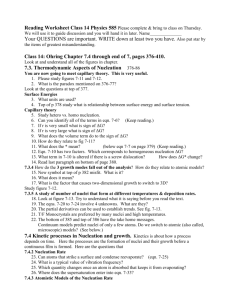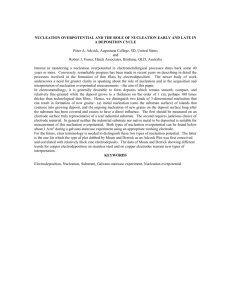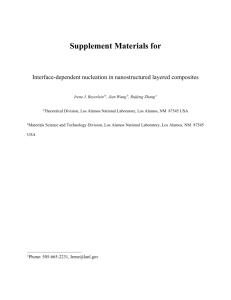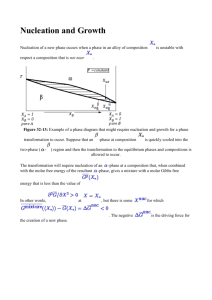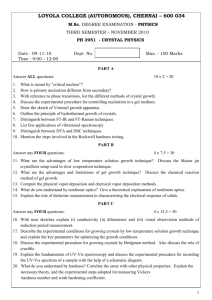Nucleation of Iron Dust from Type II Supernovae Lisa Fletcher
advertisement
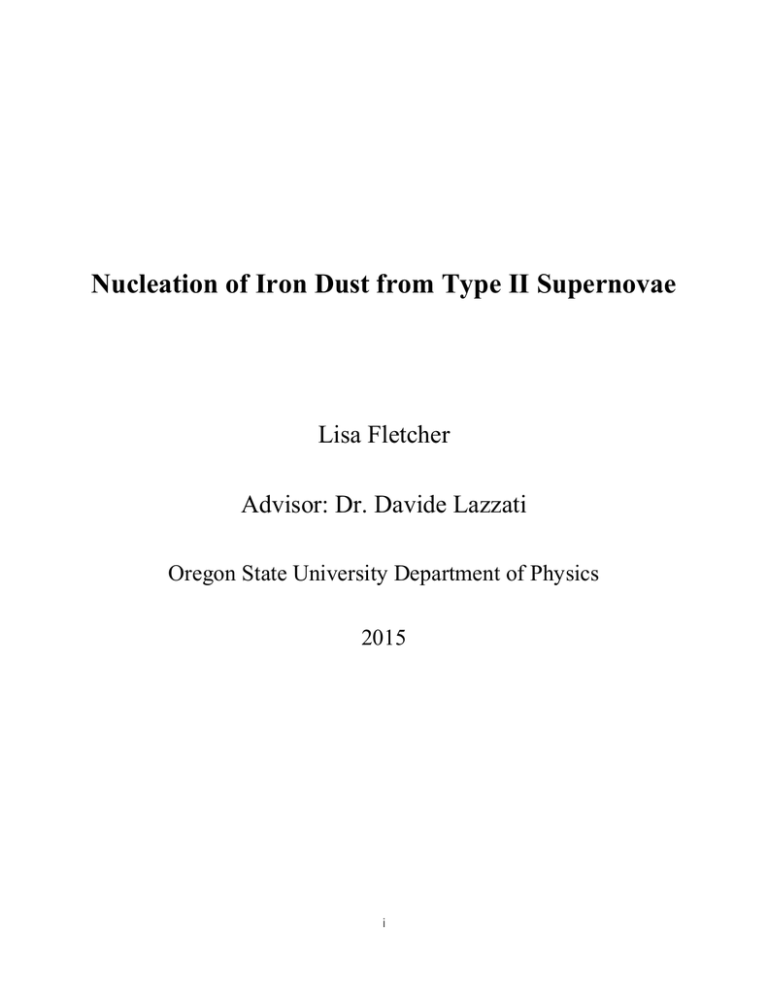
Nucleation of Iron Dust from Type II Supernovae
Lisa Fletcher
Advisor: Dr. Davide Lazzati
Oregon State University Department of Physics
2015
i
Abstract
When a star dies in a supernova, its constituent particles are torn apart and a gaseous cloud
of atoms remains. These atoms may eventually condense again into large bodies such as
planets and stars. There are three main theories as to how this happens: classical, kinetic, and
non-local thermodynamic equilibrium (non-LTE). In the classical theory, no nucleation can
occur below a critical density and saturation and does not account for much of the nucleation
that must occur in the interstellar medium(ISM). The kinetic and non-LTE theories allow for
nucleation to occur below the classical critical levels. Most research into this area so far has
been focused on the formation of carbon dust. Carbon has a very specific geometry and
behaves rather uniquely from a chemical perspective. I was curious as to how a difference in
atomic geometry and chemical behavior would affect the formation of dust particles. To
investigate this, I am studying the formation of iron dust in supernova remnants. The
assumptions that the iron in the supernova remnants exists solely as individual atoms, that
the iron atoms are spherical, and that cloud is composed solely of iron atoms all simplified
the initial results. Once reasonable results are obtained with these assumptions, they may be
removed in order to get a more realistic picture of the formation of iron dust.
ii
Table of Contents
Chapter 1 – Introduction and Background .................................................................................................... 1
1.1
Dust Nucleation and Planet Formation ..................................................................................... 1
1.2
Nucleation Models ....................................................................................................................... 1
1.2.1
Classical Model ..................................................................................................................... 1
1.2.2
Kinetic Model ....................................................................................................................... 2
1.2.3
Non-LTE Nucleation............................................................................................................. 3
Chapter 2 – Methods ..................................................................................................................................... 4
2.1 Writing the Program ........................................................................................................................... 4
Chapter 3 – Results ....................................................................................................................................... 6
3.1 Obstacles and Problems ...................................................................................................................... 6
3.2 Data and Results ................................................................................................................................. 7
Chapter 4 – Analysis and Discussion............................................................................................................ 8
4.1 Data Analysis ...................................................................................................................................... 8
Chapter 5 – Conclusion ................................................................................................................................. 9
5.1 Conclusions ......................................................................................................................................... 9
5.2 Future Research .................................................................................................................................. 9
Bibliography ............................................................................................................................................... 10
List of Figures ............................................................................................................................................. 10
Appendix ..................................................................................................................................................... 11
iii
Chapter 1 – Introduction and Background
1.1 Dust Nucleation and Planet Formation
In order for bodies such as stars and planets to form, much smaller particles, or dust, must first
form via the process of nucleation from the gaseous remains of supernovae. If these tiny grains
of dust manage to attain a minimum, critical size, they may continue to grow. Should the grain
just reach the critical size, it may maintain an equilibrium where the number of atoms accreting
onto it is exactly equal to the number evaporating away. Anything larger than the critical size
will tend to grow, as the amount of stuff attaching to the grain is greater than the amount
breaking away. These grains will then attract one another, more and more so as they grow larger
and become more significant, and may become lager bodies such as planetoids or, depending on
their chemical composition, stars. Many grains never reach this critical size, however, and they
will tend to evaporate away.
1.2 Nucleation Models
1.2.1 Classical Model
The classical nucleation model can be applied to a number of phenomena, such as the formation
of water vapor into clouds and the growth of sugar crystals into rock candy and essentially
assumes a change of thermodynamic state. According to the classical theory, there must already
be present an impurity or preformed crystal around which nucleation may occur and the
temperature, density, and saturation of the substance in question must be within ideal ranges.
1
While the requirements of the classical theory are valid if one is watching water freeze into ice, it
makes less sense when confronted with the vaporized remnants of a supernova. This very
simplified view of the process of nucleation is the starting point of this project.
1.2.2 Kinetic Model
The kinetic theory of nucleation allows nucleation to occur under subsaturated conditions.
Generally, the kinetic model predicts higher nucleation rates as it tends not to overpredict the
surface free energy of very small grains as the classical model does (Nowakowski &
Ruckenstein, 1991). Experimental results for simple alcohols, as seen in Figure 1 for ethanol,
show that both the classical and kinetic models are valid under certain conditions and that some
other mechanism is needed to understand why the nucleation behavior of these molecules goes
from one paradigm to the other.
2
Figure 1 Experimental results of the nucleation of ethanol in argon gas and classical and kinetic predictions (Nowakowski &
Ruckenstein, 1991)
1.2.3 Non-LTE Nucleation
In the classical view, nucleation cannot occur below the critical densities and saturations, both of
which depend upon the temperature of the gas cloud in question. However, once saturation and
density drop very low, non-local thermodynamic equilibrium nucleation will begin (Lazzati,
2008). In these situations, the temperature of the gas also decreases and the detachment of
particles from a grain is suppressed (Lazzati, 2008) allowing nucleation to occur below the
classically accepted region.
3
Figure 2 Nucleation diagram for graphite in hydrogen gas (Lazzati, 2008)
Chapter 2 – Methods
2.1 Writing the Program
A computer program was written to simulate the nucleation of iron dust from the interstellar
remains of a supernova using Python as the chosen programming language. A majority of the
work required to successfully simulate the formation of dust grains came in properly defining
variables and constants necessary to calculate the nucleation current
4
1
2 2 2
4 3
J
clk exp
2
27 ln S
mlk
(Todini & Ferrara, 2001). Where mlk is the mass of individual atoms, clk is the concentration of
atoms in the gas,
4 a0
, a0 is the radius of the atoms, is the specific surface energy, k B
kBT
is the Boltzmann constant, T is gas temperature, is the sticking coefficient (which is typically
4
set to 1), a03 is the volume of a single atom, and S is the supersaturation ration defined
3
by ln S
Gr
vi ln Pi (Todini & Ferrara, 2001). Ultimately, the nucleation current is
RT
i
dependent upon the temperature and saturation of the dust cloud, the density of iron particles in
the cloud, and time, meaning that the variables upon which J depends had to be allowed to
depend upon these as well.
A key step in the program had to do with properly varying the density and saturation of the dust
cloud. Over time, the density of particles within the remains of a supernova is reduced by means
of two mechanisms. First, the dust cloud expands over time, increasing the distance between
particles and decreasing the concentration of the cloud. Second, the number of iron atoms left
available to form dust grains decreases as more grains form and as existing grains increase in
size. The saturation of iron particles is a function of the instantaneous density of iron particles in
the cloud and of the critical density required to allow nucleation to occur. This means that only
the equation for density needed to account for both of these mechanisms. Implementing the
dependence of the density on the increasing volume was a simple matter of multiplying the
initial density by the ration of the initial volume to the instantaneous volume. Due to the
5
complicated dependence of the nucleation rate upon the gas temperature, the reduction of the
number of iron particles available to nucleate required the inclusion of both a term describing the
number of grains being formed and one describing the addition of new iron atoms to existing
grains as a function of the surface area of the grain. This was accomplished using a for loop to
vary this number as a function of time. The successful implementation of this code produces a
very idealized, classical version of the nucleation of iron particles from a gas cloud.
The complete Python code used to generate the results is included as an appendix.
Chapter 3 – Results
3.1 Obstacles and Problems
Once the program was running and all of the pieces were in place, a major road block was
finding a range for initial conditions that produced notable results. Initially, the effect of
nucleation on the density of the gas cloud was overwhelmed by the change in density due to the
expansion of the cloud and was so small as to be negligible. In order to get closer to a realistic
model as well as to see meaningful results, the term describing the growth of already formed dust
particles was added via
dn clk
k BT
2 m
(Lazzati, 2008), where dn is the number of particles attaching to the dust grains. This was
expected to eat up the iron atoms within the cloud much more quickly than forming new dust
particles had. Unfortunately, the output of the program remained essentially unchanged as the
6
decrease in density and temperature of the cloud were not affected enough by the formation of
dust to produce noticeable results.
3.2 Data and Results
The change in the density, saturation, and temperature of the cloud due only to the change in
volume as a function of the distance from the center of the original supernova explosion can be
seen modeled in Figure 3.
Figure 3 Evolution of a cloud of iron atoms in which no nucleation takes place
When a term taking into account the nucleation current J was added to the density of the cloud,
the program returned Figure 4 as its output. The supersaturation ratio S is the ratio between the
current density and the critical density for the current temperature; nucleation cannot occur until
7
S is greater than 1. Once nucleation can happen, it appears to be too small to have a notable
effect on the density curve.
Figure 4 Evolution of a cloud of iron atoms including the formation of dust particles
Chapter 4 – Analysis and Discussion
4.1 Data Analysis
My results do not seem to indicate that the formation of dust particles from a cloud of iron atoms
has any notable effect on the density, saturation, or temperature of the cloud. A number of
changes to the initial conditions and to the syntax and formatting of the equations in the program
all yielded the same results. The beginning stages of nucleation, i.e. the formation of dust grains
of more than one atom of iron, will have little to no effect on the cloud. One would assume that
8
the growth of these grains up to and beyond the critical radius will have a much more dramatic
effect on the could as a whole, as larger and larger grains will have more surface areas for the
free atoms and smaller grains to stick to.
Chapter 5 – Conclusion
5.1 Conclusions
The very simplified model of nucleation that my program demonstrates does not take into
account the vast majority of what must be really happening as stars and planets form from the
remnants of supernovas. The beginning stages of the formation of dust grains does not have
enough of an effect on the density of the cloud to be observed. Moving forward, the inclusion of
equations representing more aspects of the phenomenon should begin to yield notable results.
5.2 Future Research
Ideally, an accurate to observation model of iron dust nucleation will be realized by continuing to
add complications into a system like the one I have begun. These would include the effects of not
only classical nucleation, but also the kinetic and non-LTE effects at lower temperatures,
densities, and saturations of the ISM as well as other effects we have yet to observe or model.
The immediate next step would be to include in the program a term representing the growth of
the dust grains up to and beyond the critical size and another demonstrating the detachment of
particles from the growing grains. As in most areas of physics, one may approach a model very
similar to the actual process by which gases and dust become planets and stars, but the true
model will include many more effects than we can realistically account for.
9
Bibliography
Feder, J., Russell, K., Lothe, J., & Pound, G. (1966). Homogeneous nucleation and growth of droplets in
vapours. Advances in Physics, 111-178.
Keith, A. C., & Lazzati, D. (2011). Thermal fluctuations and nanoscale effects in the nucleation of
carbonaceous dust grains. Monthly Notices of the Royal Astronomical Society, 685-693.
Lazzati, D. (2008). Non-local thermodynamic equilibrium dust nucleation in subsaturated vapours.
Monthly Notices of the Royal Astronomical Society, 165-172.
Nowakowski, B., & Ruckenstein, E. (1991). A kinetic approach to the theory of nucleation in gases. Journal
of Chemistry and Physics, 94(2), 1397-1402.
Todini, P., & Ferrara, A. (2001). Dust formation in primordial Type II supernovae. Monthly Notices of the
Royal Astronomical Society, 726-736.
List of Figures
Figure 1 Experimental results of the nucleation of ethanol in argon gas and classical and kinetic
predictions (Nowakowski & Ruckenstein, 1991) ......................................................................................... 3
Figure 2 Nucleation diagram for graphite in hydrogen gas (Lazzati, 2008) ................................................. 4
Figure 3 Evolution of a cloud of iron atoms in which no nucleation takes place ......................................... 7
Figure 4 Evolution of a cloud of iron atoms including the formation of dust particles ................................ 8
10
Appendix
Following is the text of the program used to generate the results presented herein.
import numpy as n
import pylab as p
from math import pi
from math import exp
from math import log
def crit_dens(T):
kB=1.38e-16 # Boltzmann's constant in CGS
logPPa=12.106-21723./T+0.4536*n.log(T)-0.5846*T**(-3)*.01
# from Wikipedia
Pres=n.exp(logPPa)
dens=Pres/kB/T
return dens
volume0=1.
# the volume of the nucleating region at t=0
density0=1e13
# the numeric density (atoms per cm3) of iron at t=0
temperature0=5000.
# the temperature in Kelvin at t=0
velocity=100.*1e5
# the expansion velocity of the gas parcel in cm/s
distance0=1e13
# initial distance in cm from the center of the SN explosion
11
# Some constant values for Iron
sigma=1800.
# the surface tension of Iron in erg/cm^2
a0=1.411e-8
# interatomic radius in cm
omega=4./3.*n.pi*a0**3
#vol of a molecule in condensed phase in cm^3
alpha=1.
#sticking coefficient
m=9.27e-23
#mass of iron atom in g
kB=1.38e-16
#Boltzmann's constant
# set time base for numerical integration
dt=100.
# the time interval in seconds
tmin=0.
# the initial time in seconds
tmax=3000000.
# the final time in seconds
times=n.arange(tmin,tmax+dt/2.,dt) # the array of times
nt=times.size
# the number of elements in the time array
# calculating quantities as a function of time
distance=distance0+velocity*times
volume=volume0*(distance/distance0)**3
temperature=temperature0*(volume0/volume)**(2./3.)
# calculating the critical density at various temperatures
crit_density=n.empty(nt)
for i in range(nt):
crit_density[i]=crit_dens(temperature[i])
density=n.zeros(nt)
12
r_critical=n.zeros(nt)
saturation=n.zeros(nt)
J=n.zeros(nt)
drhoNucl=n.zeros(nt)
density[0]=density0
for i in range(1,nt):
dV=volume[i]-volume[i-1]
d_density=-density[i-1]/volume[i-1]*dV
saturation[i]=density[i-1]/crit_density[i-1]
r_critical[i]=2.*sigma*omega/(kB*temperature[i]*n.log(saturation[i]))
# dA=4.*n.pi*(r_critical[i])**2.-4.*n.pi*(r_critical[i-1])**2
# dn=density[i-1]*(kB*temperature[i]/(2*n.pi*m))**.5*dt*dA
#Terms to be used
later when adding the
effect of grain growth
mu=4*n.pi*a0**2*sigma/kB/temperature[i]
if saturation[i]>1: J[i]=alpha*omega*(2.*sigma/(n.pi*m))**.5*density[i-1]**2*n.exp(4*mu**3/(27.*n.log(saturation[i])**2))
else: J[i]=0
drhoNucl[i]=4./3.*n.pi*(r_critical[i])**3/omega*J[i]*dt
density[i]=density[i-1]+d_density-drhoNucl[i]
jj=n.where(saturation<1)
J[jj]=0
# plotting results
p.close(1)
p.figure(1)
p.title('Iron Nucleation')
p.semilogy(times,density,label='density')
p.plot(times,temperature,label='temperature')
p.plot(times,saturation,label='supersaturation ratio')
p.plot(times,J,label='nucleation current')
p.xlabel('time (sec)')
p.legend(loc='lower left')
p.ylim([1e-40,1e18])
p.show()
13

